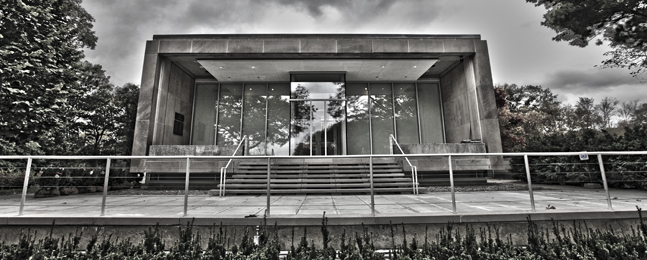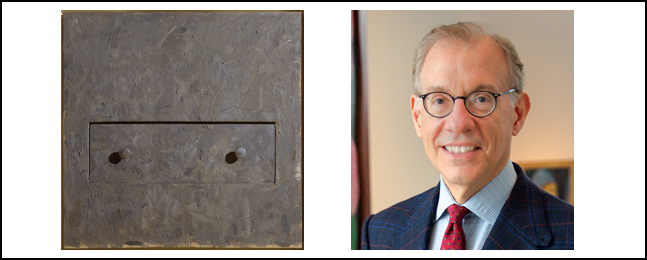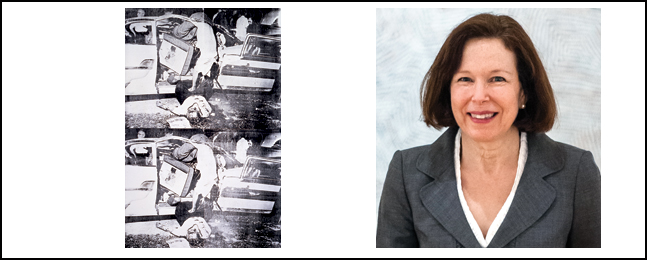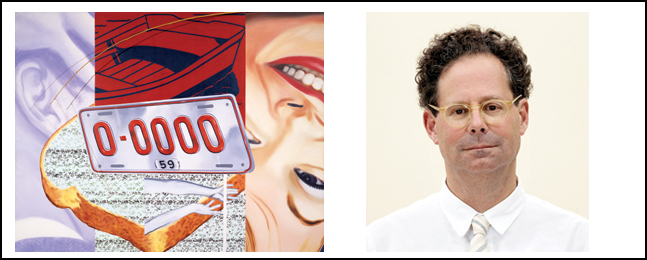A Rose-Tinted Art World
Three leading curators discovered their lifelong passion as students at Brandeis’ art museum.

Mike Lovett
Rose Art Museum
by David Menconi
If anybody was born to run an art museum, it’s Gary Tinterow ’76, director of the Museum of Fine Arts, Houston. At the precocious age of 8, he was already making his own exhibitions.
“I’d cut pictures of works of art out of magazines and arrange them in displays on my desk,” Tinterow remembers. “I didn’t know anything about museum curators, but I was interested in art, and we would visit museums all the time. I got interested in the container as well as the content.”
When he arrived at Brandeis, Tinterow planned to major in American studies and go on to law school. But the university’s Rose Art Museum — founded in 1961, with a permanent collection featuring important works by Andy Warhol, Roy Lichtenstein and Jasper Johns — changed all that. He was working as a student assistant at the Rose by his sophomore year.
Right behind Tinterow, Adam Weinberg ’77 and Kimerly Rorschach ’78 also found their way into the art-museum world by understudying at the Rose. None of them came to Brandeis planning to make museums a career. Yet four decades on, this trio runs three of the most prominent art institutions in America, thanks in large part to their time at the Rose.
Tinterow spent 28 years as a curator at New York’s Metropolitan Museum of Art before leaving in 2012 to go back to his hometown, Houston, as director of the Museum of Fine Arts, Houston (MFAH). Already one of America’s largest art museums, the MFAH is growing even larger in the wake of a recently announced $450 million expansion project.
After stints at art museums in Paris, Minneapolis and Toledo, Ohio, Weinberg returned to his hometown, New York City, to become director of the renowned Whitney Museum of American Art in 2003. The Whitney has just undergone its own bold expansion, moving this spring into a new building in New York City’s meatpacking district.
And after spending the better part of a decade launching Duke University’s Nasher Museum of Art, Rorschach left that post in 2012 to become director of the Seattle Art Museum, one of the best museums on the West Coast.
Add in Annette Carlozzi ’76, who enjoyed a long, distinguished curatorial career at New Orleans’ Contemporary Arts Center and other galleries before retiring last year, and it’s an impressive concentration of museumindustry talent who emerged from Brandeis and the Rose at about the same time.
Tinterow, Weinberg and Rorschach “are running three of the largest, most important museums in the country,” says Michael Conforti, director of the Clark Art Institute, in Williamstown, Mass., who has known each of them for many years. “The Whitney is probably best-known nationally. People may not realize just how special Houston has become and how Seattle has grown.
“All three curators are very different, which is intriguing,” continues Conforti. “They operate their institutions differently, with different personality types. But they all have a powerful understanding of the visual and an ability to communicate in special ways the value of the visual to publics other than trustees and donors.
“Each has a vision of the role of art in society, and the importance of museums to culture. I don’t think that happened by accident.”
‘A marvelous ride’
When Tinterow arrived on campus in 1972, he already had an eye and a sensibility. His introduction to the Rose came through the museum’s art-lending program for students, through which he borrowed Lichtenstein and Warhol lithographs to hang in his dorm room.
By then the Rose, scarcely a decade old, had built a growing reputation. The museum flourished early under the prescient eye of legendary curator Sam Hunter, who used a $50,000 grant from the Mnuchin family to build a permanent collection of works by artists destined to become 20th-century giants.
As a senior, Tinterow was the rare undergraduate entrusted with curating a show of his own at the Rose — an exhibition of photographs that covered 200 years of American synagogue architecture, which he put together in cooperation with the American Jewish Historical Society.
Throughout college, Tinterow held summer internships at the MFAH, his future professional home. After graduating, he got his MFA at Harvard, then landed a curatorial position at the Met in 1983.
 |
|
Gary Tinterow's favorite work of art at the Rose? “No contest — it’s ‘Drawer,’ by Jasper Johns,” he says. “So powerful in its mysteriousness, resonating with Cezanne and a host of other touchstones. The Rose has lots of icons — Warhol, de Kooning, Lichtenstein — but the Johns continues to haunt me.” (Art © Jasper Johns / Licensed by VAGA, New York, NY. Tinterow photo by Carrithers Studio.) |
page 2 of 3
He very nearly never left. Over his 28-year tenure at the Met, Tinterow earned a reputation for making big things happen, such as helping arrange the 1993 acquisition of van Gogh’s “A Wheatfield With Cypresses” (bought by Walter Annenberg for $57 million and then donated to the museum). He also oversaw the museum’s On the Roof program, presenting “Big Bambú” and other site-specific installations. And he organized more than 40 Met exhibitions, most notably a 2010 Picasso show that drew more than 700,000 people.
“The Met was a marvelous ride,” Tinterow says. “I can’t believe it’s over or how fast the time flew. Then I look at my bookshelf with all the exhibition catalogs I participated in developing and can’t believe I did all that, either. How it all happened, I don’t know.”
Though there are few obvious moves up from the perch afforded by the Met, the chance to run his own museum was too alluring for Tinterow to pass up. In 2012, he left the Met for Houston to replace Peter Marzio, who ran the MFAH for 28 years before his death in 2010. Tinterow set ambitious plans into motion, including the expansion project that will transform the MFAH landscape with a pair of new buildings by 2019.
Houston’s $1 billion endowment ranks third among American museums, surpassed only by Los Angeles’ J. Paul Getty Trust and the Met. With Tinterow and his colleagues working overtime to raise funds, donors have already contributed $335 million toward the expansion project’s $450 million cost.
“It’s a very enviable position,” Tinterow acknowledges when asked about the MFAH endowment. “But it’s still never enough. We’re on a very tight budget here, actually.
“We’ve got 600 employees, a $60 million operation,” he says. “Half of it is supported by the endowment. The other half we have to raise every year, whether by income or donations. So we’re out there hustling every year.”
Bigger and brighter
Compared with Tinterow, Rorschach took a more meandering route to museum work. She came to Brandeis to study the Soviet Union and prepare for the diplomatic corps.
What drew her to South Street? Two radical activists, feminist Angela Davis ’65 and Yippie/Chicago Seven ringleader Abbie Hoffman ’59, had gone to Brandeis.
“I thought that was awesome,” Rorschach says, laughing a bit sheepishly. “It was the mid-’70s, and I was coming from a conservative private-school upbringing in Houston. The fact that these revolutionary people had gone to Brandeis wanting to change the world was exciting to me. So I went to Brandeis, too.”
An art-history survey course (the Renaissance through the 19th century) made Rorschach reconsider her major. The courses then Rose director Carl Belz taught on modern art and museums, which included a heavy concentration of insight into how museums really operate, clinched her career track.
“I figured out that if you want to study works of art, you have to go where they live — museums,” Rorschach says.
She continued to work and study at the Rose while (like fellow Houstonian Tinterow) interning back home during the summer. After earning a PhD at Yale, she worked at museums in Philadelphia and Chicago, then landed at Duke University in 2004, just in time to oversee construction of the brand-new Nasher Museum of Art from the ground up.
Since its opening in 2005, the Nasher has competed with the big boys. Its 13,000-piece permanent collection includes works by Picasso, Warhol, Rodin and Matisse. Under Rorschach, the museum staged exhibitions that drew nationwide attention. In 2008, The Wall Street Journal named “El Greco to Velásquez,” an acclaimed exhibition of Spanish paintings, one of the year’s top-10 shows in the U.S.
As someone running a museum affiliated with a private university, Rorschach understood academia’s budgetary challenges better than most museum directors. But she was still shocked by the January 2009 announcement that the Rose would close down and sell off its permanent collection to shore up Brandeis’ recession-ravaged endowment.
Following protracted and loud public protests; quiet but intense private lobbying by Rorschach, Tinterow, Weinberg and many others; and litigation from museum supporters and donors (settled in 2011 under the leadership of Brandeis President Frederick Lawrence), the Rose was saved.
 |
|
“There are so many great, iconic works from the ’50s and ’60s in the Rose collection,” Kimerly Rorschach says. “But my favorite is Andy Warhol’s ‘Saturday Disaster.’ It’s still so shocking and fresh, tough and meaningful — it speaks to younger as well as older generations.” (© 2015 The Andy Warhol Foundation for the Visual Arts, Inc. / Licensed by ARS. Rorschach photo by Robert Wade.) |
page 3 of 3
“I can’t speak to the university’s finances beyond noting that it was a challenging time for everyone,” Rorschach says carefully. “But [closing the Rose] was still not a good idea. And for me, it was very, very personal, as it was for everyone who studied there. I tried to advocate for the Rose as a great asset for Brandeis. Dismantling it would have done immense damage to the university’s mission, reputation and relationship with donors.”
Six years later, the Rose has an energetic director, Christopher Bedford, who took over in 2012 and significantly expanded the Rose’s permanent collection and staff, not to mention image.
Perhaps the most significant symbol of the Rose’s comeback is Light of Reason. A sculpture of reclaimed Victorian lampposts created by artist Chris Burden, it was commissioned for Brandeis and stands as a gateway to the museum’s front door. Bedford was instrumental in bringing the piece to campus.
“With a lot of hard work, I’d say we’ve arisen from the ashes of 2009,” Bedford says. “It’s not a way anybody would want to achieve glories, and it certainly would have been better if it hadn’t happened. But in a certain way, everything that happened did help pave the way for bigger and brighter things.”
After eight great years at the Nasher, Rorschach decided to pursue her own version of bigger and brighter. In 2012, she moved to the Seattle Art Museum, a large institution with an eclectic reputation and a permanent collection almost double the size of the Nasher’s. That year, she also served as president of the national Association of Art Museum Directors.
 |
|
Sidebar Story |
 |
In recent years, even the biggest museums have had their financial challenges The same 2008-09 economic downturn that threatened the Rose also descended in Seattle after museum development partner Washington Mutual Bank failed following a costly expansion of the museum’s building.
“It’s always been challenging, but it seems even more so now,” says Rorschach. “Museums have grown and become more complex, and we’re groping for answers just like everyone else.”
Financial support is needed to help museums fulfill a critical, irreplaceable mission, Rorschach explains. “Our unique reason for being is to preserve art for future generations. Seeing photos can’t convey scale or the live experience. That’s what we’re here for.”
The artistic here and now
The live experience has always been an important part of Adam Weinberg’s outlook at the Whitney.
Like Tinterow, art-history major Weinberg curated his own Rose exhibition, a collection of 19th-century photographs.
And like Rorschach, he was distressed about the Rose’s attempted liquidation. “It was a knee-jerk reaction to a difficult financial situation, which I understood,” he says. “But I did not feel that other options were properly explored in advance, and the proof is in the result.”
As a young man, Weinberg studied photography seriously. But his interest in museums was just as passionate, going back to a high-school internship at New York’s Guggenheim Museum.
“I still remember the first day,” he says. “I got there early and watched the curators install an exhibit by French painter and sculptor Jean Dubuffet. I’d never seen curators at work, and I was totally fascinated. That was the first moment I had the idea that working at a museum might be something to pursue.” Eventually, Weinberg realized that other people were better at making art than he was. “In the end, what I liked most was participating in the discussion, looking at the work, getting to know and work with artists, presenting their work,” he says. “The involvement in the work was what mattered to me, not to have to be the one who made it. I was interested in the process, not just the final result.”
 |
|
“I have always loved James Rosenquist’s ‘Two 1959 People,’” says Adam Weinberg, when asked about his Rose standout. “It suggests the schizophrenia of modern life. It’s about signs and the notion of art as a mark-making system. And it’s a dynamic, challenging object, unsettling to read and comprehend, yet coherent and beautiful to behold.” (Art © James Rosenquist / Licensed by VAGA, New York, NY.) |
Whereas Tinterow and Rorschach specialize in 19th-century and European art, Weinberg came to focus more on the artistic here and now, a fitting choice for someone fascinated by process.
“All art is contemporary in its time, and we are surrounded by artists making things,” Weinberg says. “Even though I very much loved art history, I was more interested in a connection with those making and creating things today.
“It’s different for museums today,” he continues. “There’s more to sort through. Art has never been confined within the walls of museums, which were basically a 19th-century invention. Art came first, museums later. And it’s interesting that museums have come to represent temples of art.”
In recent years, the Whitney’s main order of business has been its move to a new Renzo Piano-designed building on Gansevoort Street. With more than triple the space of the old Madison Avenue site, the new facility will allow far more of the Whitney’s 21,000-item permanent collection to be on display.
But, like his colleagues, Weinberg knows that keeping the temple going is different from keeping art going.
“Being in the contemporary art world is very meaningful and engaging,” he says. “The reason I went into the field was not to raise money and be a manager. That’s just a means to an end. A museum’s mission is not to be financially solvent. It’s to support artists, make their work available and care for the work it’s entrusted with.
“Managing and raising money and all that — they’re just vehicles to get to that point.”
David Menconi is a freelance writer and music critic for The News & Observer in Raleigh, N.C.
